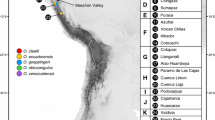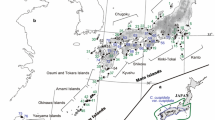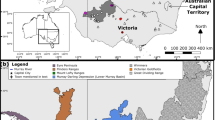Abstract
Correa (family Rutaceae) is a genus endemic to southern Australia, in which chloroplast introgression between species has previously been inferred. The current study aimed to document the extent of incongruence between molecular markers and taxonomy, describe patterns of geographic variation, and infer genetic and biogeographic processes important in the history of the genus. Sampling focused on subg. Correa (nine species) and included 166 samples from 95 localities. Samples were genotyped at the chloroplast loci trnL-trnF and trnK and the nuclear ITS regions, either by direct sequencing or by restriction digests of PCR products. Both chloroplast and ITS datasets resolved subg. Persistens (two species mostly from wet forests) as distinct from those of subg. Correa. Within subg. Correa chloroplast and ITS lineages were largely incongruent with each other and with current taxonomy, but both datasets showed similar geographic patterns. In each dataset there was one lineage mostly restricted to western South Australia and Western Australia, and one lineage widespread in eastern South Australia, Victoria, Tasmania, New South Wales and Queensland. The split between these geographic lineages occurs in South Australia, on the western side of the Murray basin; it is sharply defined in the chloroplast results, whereas the distributions of ITS lineages overlap. The geographic patterns and incongruence exhibited by both ITS and chloroplast markers provide evidence for substantial chloroplast and nuclear introgression between species. Geographic distributions of genetic lineages are consistent with divergence caused by a historical vicariance event across the lower Murray basin and subsequent reconnection of populations.








Similar content being viewed by others
References
Altschul SF, Madden TL, Schäffer AA, Zhang J, Zhang Z, Miller W, Lipman DJ (1997) Gapped BLAST and PSI-BLAST: a new generation of protein database search programs. Nucl Acids Res 25:3389–3402
Álvarez I, Wendel JF (2003) Ribosomal ITS sequences and plant phylogenetic inference. Molec Phylogenet Evol 29:417–434
Anderson RJ (1983) Variation and evolution in Correa (Rutaceae). PhD Thesis, La Trobe University, Melbourne
Anderson RJ (1986) Correa. In: Jessop JP, Toelken HR (eds) Flora of South Australia, vol 3. South Australian Government Printing Division, Adelaide, pp 771–777
Ashby E (1939) Review of the South Australian representatives of the genus Correa, with descriptions of three new species. Proc Linn Soc London 151:214–221
Avise JC (1989) Gene trees and organismal histories—a phylogenetic approach to population biology. Evolution 43:1192–1208
Avise JC (2004) Molecular markers, natural history, and evolution. Sinauer Associates, Sunderland
Bandelt HJ, Forster P, Röhl A (1999) Median-joining networks for inferring intraspecific phylogenies. Molec Biol Evol 16:37–48
Barrett RA, Bayly MJ, Duretto MF, Forster PI, Ladiges PY, Cantrill DJ (2015) A chloroplast phylogeny of Zieria (Rutaceae) in Australia and New Caledonia shows widespread incongruence with species-level taxonomy. Austral Syst Bot 27:427–449
Bayly MJ, Udovicic F, Gibbs AK, Parra-O C, Ladiges PY (2008) Ribosomal DNA pseudogenes are widespread in the eucalypt group (Myrtaceae): implications for phylogenetic analysis. Cladistics 24:131–146
Bayly MJ, Holmes GD, Forster PI, Cantrill DJ, Ladiges PY (2013) Major clades of Australian Rutoideae (Rutaceae) based on rbcL and atpB sequences. PLOS One 8:e72493. doi:10.1371/journal.pone.0072493
Bentham G (1863) Flora Australiensis: a description of the plants of the Australian territory. Lovell Reed and Co, London
Birky CW Jr (1983) An approach to population and evolutionary genetic theory for genes in mitochondria and chloroplasts, and some results. Genetics 103:513–527
Black JM (1933) Flora of South Australia. Government Printer, Adelaide
Boardman R (1986) The history and evolution of South Australia’s forests and woodlands. In: Wallace HR (ed) The ecology of the forests and woodlands of South Australia. Government Printer, Adelaide, pp 16–31
Bowler JM (1980) Quaternary chronology and palaeohydrology in the evolution of mallee landscapes. In: Storrier RR, Stannard MM (eds) Aeolian landscapes in the semi–arid zone of southeastern Australia. Riverina Society of Soil Science, Wagga Wagga, pp 17–36
Burger WC (1975) The species concept in Quercus. Taxon 24:45–50
Byrne M (2008) Evidence for multiple refugia at different time scales during Pleistocene climatic oscillations in southern Australia inferred from phylogeography. Quaternary Sci Rev 27:2576–2585
Byrne M, Yeates DK, Joseph L, Kearney M, Bowler J, Williams MAJ, Cooper S, Donnellan SC, Keogh JS, Leys R, Melville J, Murphy DJ, Porch N, Wyrwoll KH (2008) Birth of a biome: insights into the assembly and maintenance of the Australian arid zone biota. Molec Ecol 17:4398–4417
Cassens I, Mardulyn P, Milinkovitch MC (2005) Evaluating intraspecific “network” construction methods using simulated sequence data: do existing algorithms outperform the global maximum parsimony approach? Syst Biol 54:363–372
Clement M, Posada D, Crandall K (2000) TCS: a computer program to estimate gene genealogies. Molec Ecol 9:1657–1963
Cook EJ (2009) A record of late Quaternary environments at lunette-lakes Bolac and Turangmoroke, western Victoria, Australia, based on pollen and a range of non-pollen palynomorphs. Rev Palaeobot Palynol 153:185–224
Costermans L (1981) Native trees and shrubs of south-eastern Australia. Weldon Publishing, Sydney
Crisp MD, Linder HP, Weston PH (1995) Cladistic biogeography of plants in Australia and New Guinea: congruent pattern reveals two endemic tropical tracks. Syst Biol 44:457–473
Currat M, Ruedi M, Petit R, Excoffier L (2008) The hidden side of invasions: massive introgression by local genes. Evolution 62:1908–1920
Després L, Gielly L, Redoutet B, Taberlet P (2003) Using AFLP to resolve phylogenetic relationships in a morphologically diversified plant species complex when nuclear and chloroplast sequences fail to reveal variability. Molec Phylogenet Evol 27:185–196
Dodson JR, Ono Y (1997) Timing of late Quaternary vegetation response in the 30–50° latitude bands in southeastern Australia and northeastern Asia. Quaternary Int 37:89–104
Doyle JJ, Doyle JL (1987) A rapid DNA isolation procedure for small quantities of fresh leaf tissue. Phytochem Bull 19:11–15
Duretto MF (1999) Rutaceae. In: Walsh NG, Entwisle TJ (eds) Flora of Victoria, vol 4. Inkata Press, Melbourne, pp 153–197
Elshire RJ, Glaubitz JC, Sun Q, Poland JA, Kawamoto K, Buckler ES, Mitchell SE (2011) A robust, simple genotyping-by-sequencing (GBS) approach for high diversity species. PLOS One 6(5):e19379
Engler A (1931) Rutaceae. In: Engler A, Harms H (eds) Die Naturlichen Pflanzenfamilien, vol 19a. Wilhelm Engelmann, Leipzig, pp 187–358
Excoffier L, Laval G, Schneider S (2005) Arlequin ver. 3.0: an integrated software package for population genetics data analysis. Evol Bioinform Online 1:47–50
Feliner GN, Rossellò JA (2007) Better the devil you know? Guidelines for insightful utilization of nrDNA ITS in species-level evolutionary studies in plants. Molec Phylogenet Evol 44:911–919
Ferris C, Oliver RP, Davy AJ, Hewitt GM (1993) Native oak chloroplasts reveal an ancient divide across Europe. Molec Ecol 2:337–343
Freeman JS, Jackson HD, Steane DA, McKinnon GE, Dutkowski GW, Potts B, Vaillancourt R (2001) Chloroplast DNA phylogeography of Eucalyptus globulus. Austral J Bot 49:585–596
Gibbs MJ, Armstrong JS, Gibbs AJ (2000) Sister-Scanning: a Monte Carlo procedure for assessing signals in recombinant sequences. Bioinform 16:573–582
Grant V (1981) Plant speciation. Columbia University Press, New York
Grivet D (2002) Phylogeography of the common ivy (Hedera sp.) in Europe: genetic differentiation through space and time. Molec Ecol 11:1351–1362
Groppo M, Pirani JR, Salatino MLF, Blanco SR, Kallunki JA (2008) Phylogeny of Rutaceae based on two noncoding regions from cpDNA. Amer J Bot 95:985–1005
Hayman D (1960) The distribution and cytology of the chromosome races of Themeda australis in southern Australia. Austral J Bot 8:58–68
Heath L, van der Walt E, Varsani A, Martin DP (2006) Recombination patterns in aphthoviruses mirror those found in other picornaviruses. J Virol 80:11827–11832
Hollingsworth PM, Graham SW, Damon PL (2011) Choosing and using a plant DNA barcode. PLOS One 6:e19254
Jackson HD, Steane DA, Potts BM, Vaillancourt RE (1999) Chloroplast DNA evidence for reticulate evolution in Eucalyptus (Myrtaceae). Molec Ecol 8:739–751
Jennings WB, Pianka ER, Donnellan S (2003) Systematics of the lizard family Pygopodidae with implications for the diversification of Australian temperate biotas. Syst Biol 52:757–780
Käss E, Wink M (1997) Molecular phylogeny and phylogeography of Lupinus (Leguminosae) inferred from nucleotide sequences of the rbcL gene and ITS 1 + 2 regions of rDNA. Pl Syst Evol 208:139–167
Kershaw AP (1994) The Neogene: a period of transition. In: Hill RS (ed) History of the Australian vegetation: Cretaceous to recent. Cambridge University Press, Cambridge, pp 299–327
Konieczny A, Ausubel FM (1993) A procedure for mapping Arabidopsis mutations using co-dominant ecotype-specific PCR-based markers. Plant J 4:403–410
Larcombe MJ, McKinnon GE, Vaillancourt RE (2011) Genetic evidence for the origins of range disjunctions in the Australian dry sclerophyll plant Hardenbergia violacea. J Biogeogr 38:125–136
Levy L, Castlebury LA, Carris LM, Meyer RJ, Pimentel G (2001) Internal transcribed spacer sequence-based phylogeny and polymerase chain reaction-restriction fragment length polymorphism differentiation of Tilletia walkeri and T. indica. Phytopathology 91:935–940
Marginson J, Ladiges PY (1982) Morphological and geographical disjunctions in forms of Eucalyptus nitida Hook. f. (Myrtaceae): with special reference to the evolutionary significance of Bass Strait, southeastern Australia. Proc Roy Soc Victoria 94:155–167
Marginson J, Ladiges PY (1988) Geographical variation in Eucalyptus baxteri s.l. and the recognition of a new species E. arenacea.. Austral Syst Bot 1:151–170
Martin D, Rybicki E (2000) RDP: detection of recombination amongst aligned sequences. Bioinform 16:562–563
Martin DP, Posada D, Crandall KA, Williamson C (2005) A modified BOOTSCAN algorithm for automated identification of recombinant sequences and recombination breakpoints. AIDS Res Hum Retroviruses 21:98–102
Maynard Smith J (1992) Analyzing the mosaic structure of genes. J Molec Evol 34:126–129
McKinnon GE, Steane DA, Potts BM, Vaillancourt RE (1999) Incongruence between chloroplast and species phylogenies in Eucalyptus subgenus Monocalyptus (Myrtaceae). Amer J Bot 86:1038–1046
McKinnon GE, Vaillancourt RE, Steane DA, Potts BM (2004) The rare silver gum, Eucalyptus cordata, is leaving its trace in the organellar gene pool of Eucalyptus globulus. Molec Ecol 13:3751–3762
McKinnon GE, Smith JJ, Potts BM (2010) Recurrent nuclear DNA introgression accompanies chloroplast DNA exchange between two eucalypt species. Molec Ecol 19:1367–1380
Meudt HM, Bayly MJ (2008) Phylogeographic patterns in the Australasian genus Chionohebe (Veronica s.l, Plantaginaceae) based on AFLP and chloroplast DNA sequences. Molec Phylogenet Evol 47:319–338
Mir C, Jarne P, Sarda V, Bonin A, Lumaret R (2009) Contrasting nuclear and cytoplasmic exchanges between phylogenetically distant oak species (Quercus suber L. and Q. ilex L.) in Southern France: inferring crosses and dynamics. Pl Biol 11:213–226
Mole BJ, Udovicic F, Ladiges PY, Duretto MF (2004) Molecular phylogeny of Phebalium (Rutaceae: Boronieae) and related genera based on the nrDNA regions ITS 1 + 2. Pl Syst Evol 249:197–212
Nelson EC (1981) Phytogeography of southern Australia. In: Keast A (ed) Ecological biogeography of Australia. Dr W, Junk, The Hague, pp 735–757
Nevill PG, Bossinger G, Ades PK (2010) Phylogeography of the world’s tallest angiosperm, Eucalyptus regnans: evidence for multiple isolated quaternary refugia. J Biogeogr 37:179–192
Nevill PG, Despres T, Bayly MJ, Bossinger G, Ades PK (2014) Shared phylogeographic patterns and widespread chloroplast haplotype sharing in Eucalyptus species with different ecological tolerances. Tree Genet and Genomes 10:1079–1092. doi:10.1007/s11295-014-0744-y
Nylander JAA (2004) MrModeltest v2. Evolutionary Biology Centre, Uppsala University, Program distributed by the author
Othman RNA, Jordan GJ, Worth JRP, Steane DA, Duretto MF (2010) Phylogeny and infrageneric classification of Correa Andrews (Rutaceae) on the basis of nuclear and chloroplast DNA. Pl Syst Evol 288:127–138
Othman RNA, Jordan GJ, Duretto MF (2013) Morphometric analysis of Correa lawrenceana (Rutaceae) and reinstatement of var. ferruginea endemic to Tasmania. Austral Syst Bot 26:255–267
Padidam M, Sawyer S, Fauquet CM (1999) Possible emergence of new geminiviruses by frequent recombination. Virology 265:218–225
Petit RJ, Excoffier L (2009) Gene flow and species delimitation. Trends Ecol Evol 24:386–393
Posada D (2002) Evaluation of methods for detecting recombination from DNA sequences: empirical data. Molec Biol Evol 19:708–717
Posada D, Crandall KA (2001) Evaluation of methods for detecting recombination from DNA sequences: Computer simulations. Proc Natl Acad Sci USA 98:13757–13762
Rambaut A (2002) Se-Al: sequence alignment editor. Available at: http://tree.bio.ed.ac.uk/software/seal/
Rambaut A, Drummond AJ (2009) Tracer, version 1.5, MCMC trace analysis package. Available at: http://beast.bio.ed.ac.uk/Tracer
Remington CL (1968) Suture-zones of hybrid interaction between recently joined biotas. In: Dobzhansky T, Hecht MK, Steere WC (eds) Evolutionary biology. Plenum, New York
Rieseberg LH (1991) Homoploid reticulate evolution in Helianthus (Asteraceae)– evidence from ribosomal genes. Amer J Bot 78:1218–1237
Rieseberg LH, Soltis DE (1991) Phylogenetic consequences of cytoplasmic gene flow in plants. Evol Trends Pl 5:65–84
Rieseberg LH, Wendel JF (1993) Introgression and its consequences in plants. In: Harrison RG (ed) Hybrid zones and the evolutionary process. Oxford University Press, New York, pp 70–114
Rix MG, Harvey MS (2012) Phylogeny and historical biogeography of ancient assassin spiders (Araneae: Archaeidae) in the Australian mesic zone: evidence for miocene speciation within tertiary refugia. Molec Phylogenet Evol 62:375–396
Ronquist F, Huelsenbeck JP (2003) MRBAYES 3: Bayesian phylogenetic inference under mixed models. Bioinformatics 19:1572–1574
Rowe HC, Renaut S, Guggisberg A (2011) RAD in the realm of next-generation sequencing technologies. Molec Ecol 20:3499–3502
Salzburger W, Ewing GB, Von Haeseler A (2011) The performance of phylogenetic algorithms in estimating haplotype genealogies with migration. Molec Ecol 20:1952–1963
Schaal BA, Leverich WJ (2001) Plant population biology and systematics. Taxon 50:679–695
Simmons MP, Ochoterena H (2000) Gaps as characters in sequenced-based phylogenetic analyses. Syst Biol 49:369–381
Soltis DE, Kuzoff RK (1995) Discordance between nuclear and chloroplast phylogenies in the Heuchera group (Saxifragaceae). Evolution 49:727–742
Soltis DE, Johnson LA, Looney C (1996) Discordance between ITS and chloroplast topologies in the Boykinia group (Saxifragaceae). Syst Bot 21:169–185
Specht RL (1972) The Vegetation of South Australia. Government Printer, Adelaide
Stace HM, Armstrong JA, James SH (1993) Cytoevolutionary patterns in Rutaceae. Pl Syst Evol 187:1–28
Steane DA, Byrne M, Vaillancourt RE, Potts BM (1998) Chloroplast DNA polymorphism signals complex interspecific interactions in Eucalyptus (Myrtaceae). Austral Syst Bot 11:25–40
Swofford DL (2002) PAUP* 4.0b10: Phylogenetic analysis using parsimony (*and other methods). Sinauer Associates, Sunderland
Taberlet P, Gielly L, Pautou G, Bouvet J (1991) Universal primers for amplification of three non-coding regions of chloroplast DNA. Pl Molec Biol 17:1105–1109
Tsitrone A, Kirkpatrick M, Levin D (2003) A model for chloroplast capture. Evolution 57:1776–1782
Vincze T, Posfai J, Roberts RJ (2003) NEBcutter: a program to cleave DNA with restriction enzymes. Nucl Acids Res 31:3688–3691
Vos P, Hogers R, Bleeker M, Reijans M, van de Lee T, Hornes M, Frijters A, Pot J, Peleman J, Kuiper M, Zabeau M (1995) AFLP: a new technique for DNA fingerprinting. Nucl Acids Res 23:4407–4414
Wendel JF, Stewart JM, Rettig JH (1991) Molecular evidence for homoploid reticulate evolution among Australian species of Gossypium. Evolution 45:694–711
Whiffin T (1977) Volatile oils and the study of natural hybridization between Correa aemula and C. reflexa (Rutaceae). Austral J Bot 25:291–298
White TJ, Bruns T, Lee S, Taylor J (1990) Amplification and direct sequencing of fungal ribosomal RNA genes for phylogenetics. In: Innis MA, Gelfrand DH, Sninsky JJ, White TJ (eds) PCR protocols: a guide to methods and applications. Academic Press, San Diego, pp 315–322
Williams M, Prescott JR, Chappell J, Adamson D, Cock B, Walker K, Gell P (2001) The enigma of a late Pleistocene wetland in the Flinders Ranges, South Australia. Quaternary Int 83–85:129–144
Wilson PG (1961) A taxonomic revision of the genus Correa (Rutaceae). Trans Royal Soc South Australia 85:21–53
Wilson PG (1998) Notes on the genus Correa (Rutaceae). Nuytsia 12:89–105
Wilson PG (2013) Correa. Fl Australia 26:337–361
Acknowledgments
For assistance with fieldwork or provision of specimens we thank Asher Warren, Miranda Weir, Ruby Wilson, Ramadhanil Pitopang, Will Neal, Tom Hans, Ron Taylor, Daniel Ohlsen, Paul Forster, Mike Mathieson, Alison Kellow, the La Trobe University Herbarium and the National Herbarium of Victoria. Plant collecting permits were provided by the Department of Sustainability and Environment (Victoria), the Department of Primary Industries, Parks, Water and Environment (Tasmania) and the Department for Environment, Water & Natural Resources (South Australia). This work was partly supported by an Early Career Researcher grant to MJB from The University of Melbourne.
Author information
Authors and Affiliations
Corresponding author
Ethics declarations
Conflict of interest
The authors declare that they have no conflict of interest.
Additional information
Handling editor: Christian Parisod.
Electronic Supplementary Material
Below is the link to the electronic supplementary material.
606_2016_1277_MOESM1_ESM.jpg
Online Resource 1. Map showing locations of collecting sites for this study. Details for each numbered locality are given in Table 1 (JPEG 8993 kb)
606_2016_1277_MOESM2_ESM.jpg
Online Resource 2. Proof of principle restriction digests. A. trnK restriction digest with Hpy188I: lane 1 contains Easyladder (Bioline), lanes 2-4 contain samples from haplotype Group 3 and lanes 5-7 contain samples from haplotype Groups 1 and 2. B. trnK restriction digest with ApoI: lane 1 contains Easyladder (Bioline), lanes 2-3 contain samples from haplotype Group 1 and lanes 4-5 contain samples from haplotype Group 2. C. ITS2 restriction digest with ApoI: lane 1 contains Hyperladder (Bioline), lanes 2-4 contain samples from ITS Clade 2 and lanes 5-7 contain samples from ITS Clade 3 (JPEG 157 kb)
606_2016_1277_MOESM3_ESM.pdf
Online Resource 3. Strict consensus tree from MP analysis of combined cpDNA markers. This tree was used as input for the program Haploviewer to generate the haplotype network shown in Fig. 3. Bootstrap support is shown above branches and PP from Bayesian analysis is shown below branches. * = species not identified to variety due to lack of reproductive material (PDF 512 kb)
606_2016_1277_MOESM4_ESM.jpg
Online Resource 4. Sequencing chromatograms of putative hybrid (PAF160) and typical chromatograms of the ITS Clades 2 and 3. At bases which differentiate Clades 2 and 3, the putative hybrid has two peaks, representing both alternative bases and indicating the presence of two types of ITS copies in the genome of this individual (JPEG 146 kb)
Information on Electronic Supplementary Material
Information on Electronic Supplementary Material
Online Resource 1. Map showing locations of collecting sites for this study.
Online Resource 2. Proof of principle restriction digests.
Online Resource 3. Strict consensus tree from MP analysis of combined cpDNA markers.
Online Resource 4. Sequencing chromatograms of putative hybrid (PAF160) and typical chromatograms of the ITS Clades 2 and 3.
Rights and permissions
About this article
Cite this article
French, P.A., Brown, G.K. & Bayly, M.J. Incongruent patterns of nuclear and chloroplast variation in Correa (Rutaceae): introgression and biogeography in south-eastern Australia. Plant Syst Evol 302, 447–468 (2016). https://doi.org/10.1007/s00606-016-1277-7
Received:
Accepted:
Published:
Issue Date:
DOI: https://doi.org/10.1007/s00606-016-1277-7




